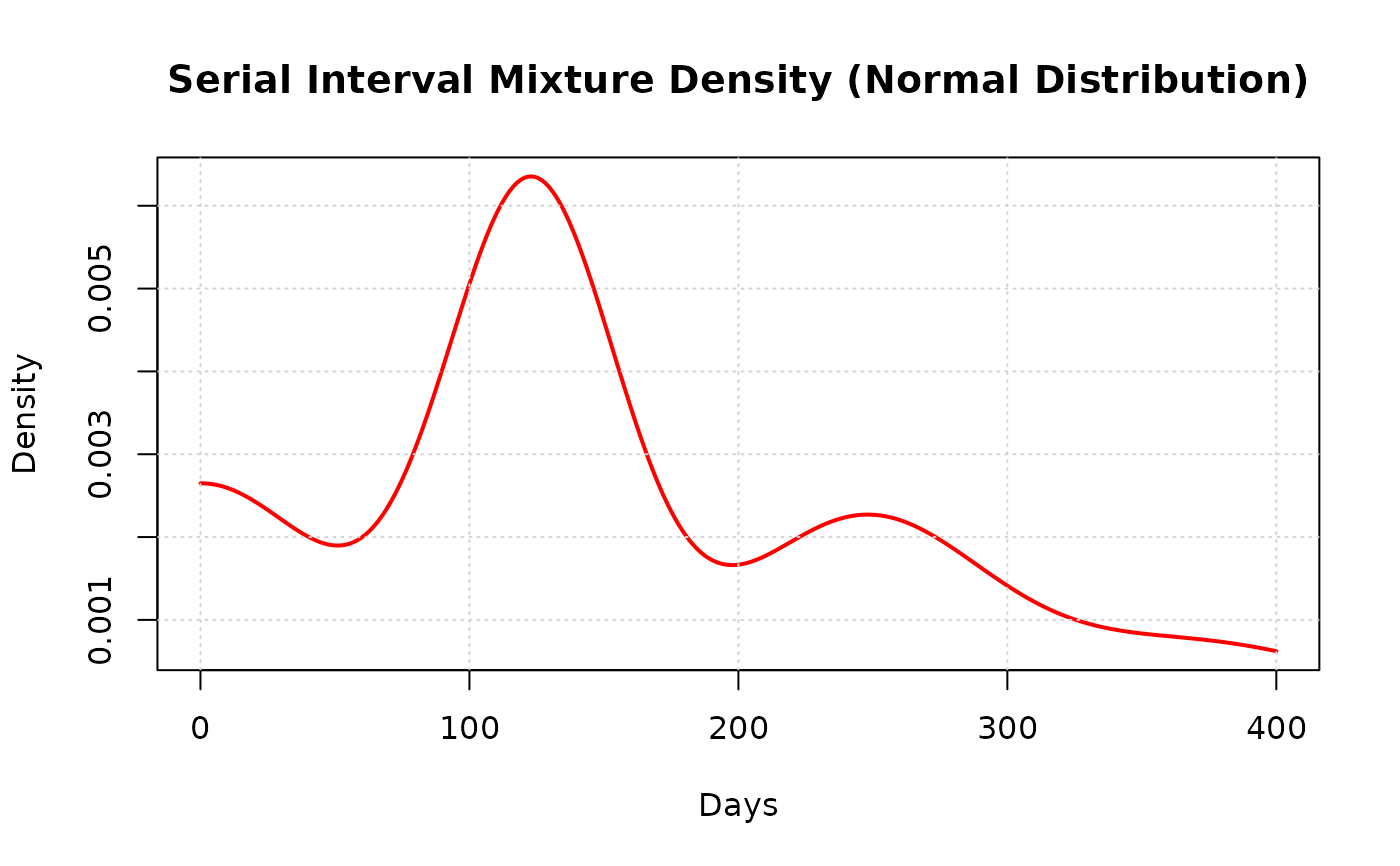
Calculate serial interval mixture density assuming underlying normal distribution
Source:R/f_norm.R
f_norm.RdThis function computes the weighted mixture density for serial intervals based on different transmission routes in an outbreak. It implements part of the Vink et al. (2014) method for serial interval estimation, assuming an underlying normal distribution for the serial interval.
Arguments
- x
quantile or vector of quantiles (time in days since index case symptom onset)
- w1
probability weight of being a co-primary case
- w2
probability weight of being a primary-secondary case
- w3
probability weight of being a primary-tertiary case
- mu
mean serial interval in days (can be any real number)
- sigma
standard deviation of serial interval in days (must be positive)
Value
Vector of weighted density values corresponding to input quantiles x. Returns the sum of densities from all four transmission routes.
Details
The function models four distinct transmission routes:
Co-primary (CP): Cases infected simultaneously from the same source
Primary-secondary (PS): Direct transmission from index case
Primary-tertiary (PT): Transmission through one intermediate case
Primary-quaternary (PQ): Transmission through two intermediate cases
Each route contributes to the overall serial interval distribution with different means and variances. The co-primary component uses a half-normal distribution to model simultaneous infections (preventing negative serial intervals), while subsequent generations follow normal distributions with means that are multiples of the base serial interval.
This function is primarily used internally by si_estim when
dist = "normal" is specified (the default), and by plot_si_fit
for visualizing fitted distributions. The normal distribution assumption allows
for negative serial intervals, which may be more realistic for some pathogens.
The weights w1, w2, and w3 must sum to <= 1, with the remaining probability (1 - w1 - w2 - w3) assigned to primary-quaternary cases. The transmission route distributions are parameterized as: Co-primary: Half-normal with scale parameter derived from sigma Primary-secondary: Normal(mu, sigma) Primary-tertiary: Normal(2*mu, sqrt(2)sigma) Primary-quaternary: Normal(3mu, sqrt(3)*sigma)
References
Vink, M. A., Bootsma, M. C. J., & Wallinga, J. (2014). Serial intervals of respiratory infectious diseases: A systematic review and analysis. American Journal of Epidemiology, 180(9), 865-875.
Examples
# Example: Plot serial interval mixture density for scabies outbreak
# Set parameters based on scabies epidemiology (longer serial interval)
mu <- 123 # Mean serial interval of 123 days (from Ainslie et al.)
sigma <- 32 # Standard deviation of 32 days
# Set transmission route weights typical for scabies
w1 <- 0.15 # 15% co-primary cases
w2 <- 0.50 # 50% primary-secondary cases
w3 <- 0.25 # 25% primary-tertiary cases
# Remaining 10% are primary-quaternary cases (1 - w1 - w2 - w3 = 0.1)
# Create sequence of time points
x <- seq(0, 400, by = 1)
# Calculate mixture density
density_values <- f_norm(x, w1, w2, w3, mu, sigma)
# Plot the result
plot(x, density_values, type = "l", lwd = 2, col = "red",
xlab = "Days", ylab = "Density",
main = "Serial Interval Mixture Density (Normal Distribution)")
grid()
